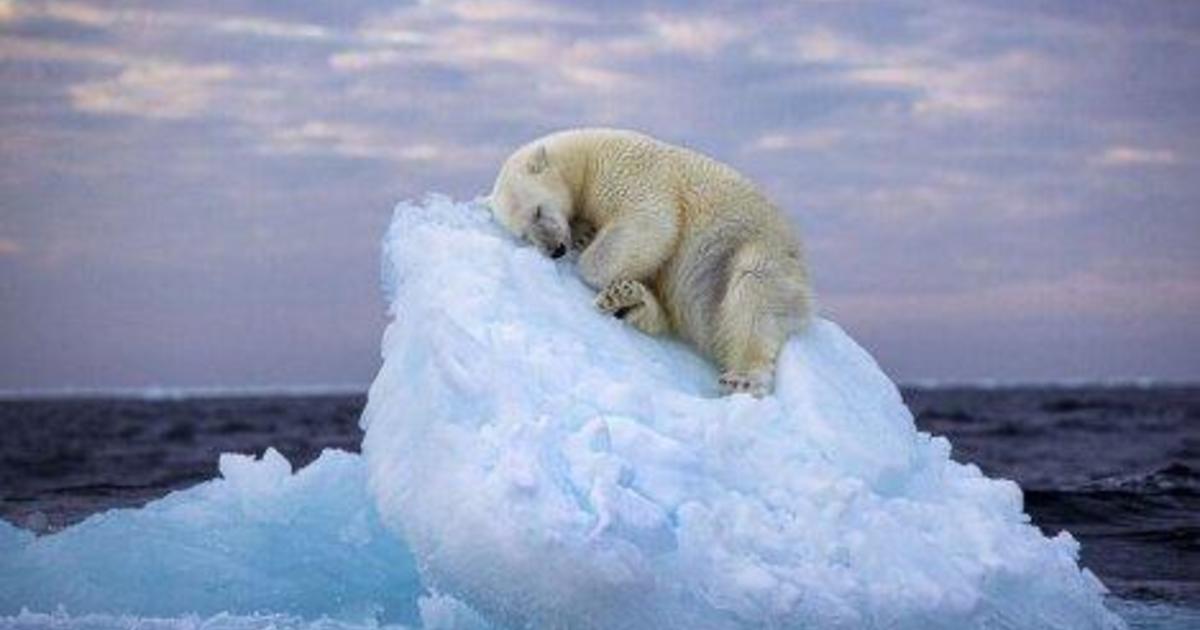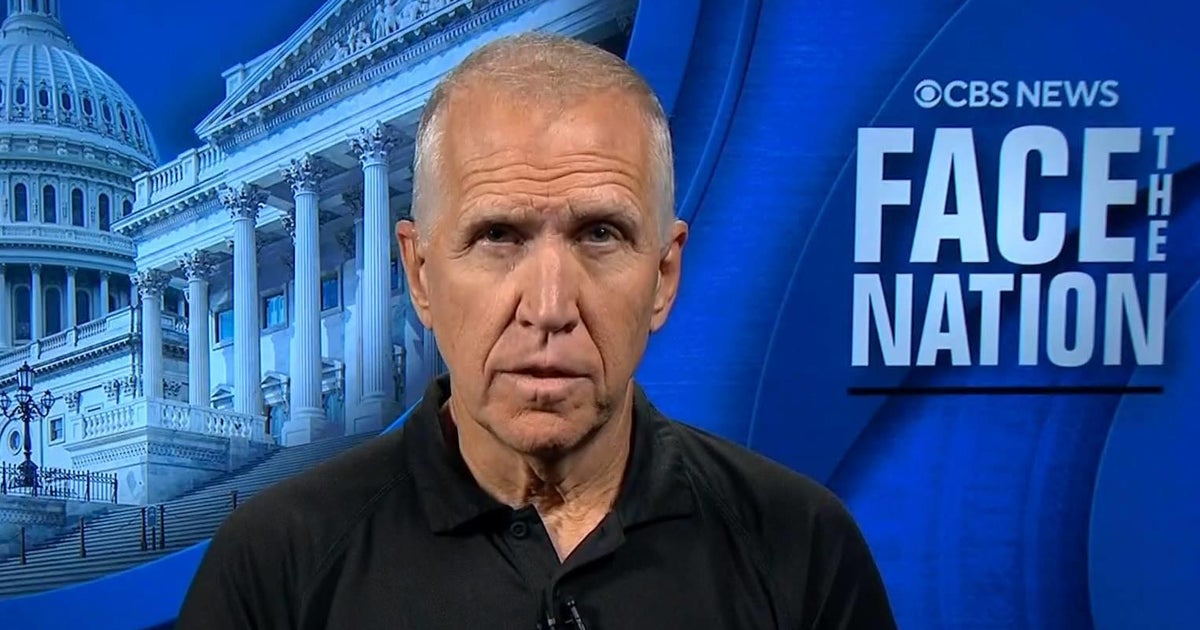CBS News
Sleepy polar bear that dug out a bed in sea ice to nap wins prestigious wildlife photography award

One of the world’s most prestigious wildlife photography awards has announced its winner – and it’s equal parts mesmerizing and adorable. The winner of the Natural History Museum of London’s Wildlife Photographer of the Year award is Nima Sarikhani, for her captivating image of a polar bear sleeping on sea ice.
The photograph, called “Ice Bed,” was captured in Norway’s Svalbard archipelago, the museum says in its description of the photo. According to a news release, Sarikhani had spent three days looking for polar bears while aboard an exploration vessel in the area, but had been having no luck as they were immersed in a “thick fog.”
But then, as the ship came across some sea ice, he saw it – two polar bears.
Those on board the ship tracked them for eight hours. And just before midnight, the moment that resonated with people worldwide finally happened.
“Under the light of the midnight sun, the bear used its powerful arms to claw out a bed on a small iceberg before drifting off to sleep,” the press release from the museum says.
Nima Sarikhani/Wildlife Photographer of the Year
Sarikhani said in the release that he’s honored to have won the People’s Choice award, which is one of nearly 50,000 entries from 95 countries. It will be on display at the museum’s Wildlife Photographer of the Year exhibit through June 30.
“This photograph has stirred strong emotions in man of those have seen it,” he said. “Whilst climate change is the biggest challenge we face, I hope that this photograph also inspires hope. There is still time to fix the mess we have caused.”
Douglas Gurr, director of the Natural History Museum, said the “breathtaking and poignant image allows us to see the beauty and fragility of our planet.”
“His thought-provoking image is a stark reminder of the integral bond between an animal and its habitat,” Gurr said, “and serves as a visual representation of the detrimental impacts of climate warming and habitat loss.”
Polar bears are known to dig themselves spots to sleep in, which are sometimes referred to as “day beds,” according to scientist Thea Bechshoft at Polar Bears International. They’re also known to take one- to two-hour-long naps, “especially after a good meal,” Bechshoft said.
According to the museum, the area in which the polar bear was captured on film is among “the most isolated in the world.” That area of the Arctic Ocean holds 19 polar bear populations that rely on the sea ice to travel and hunt offshore.
But according to a 2018 report by the Norwegian Centre for Climate Services, air temperatures in Svalbard have increased by 3 to 5 degrees Celsius over the past 40 to 50 years, conditions that have resulted in heavy winter rainfall and in some areas being “ice free most of the year.” Other areas have seen ice thickness and extent decrease “dramatically,” the museum said of the report.
“The period with sea ice over shallower water in much of the area is now much shorter than it was a few decades ago,” said Jon Aars, who researches polar bears in the region. “While the bears that follow sea ice may still be able to hunt year-round, this is increasingly over deeper waters which may be less productive.”
Less sea ice for polar bears to use as a way to safely travel has also led to the animals having less genetic diversity, Aars said.
“There aren’t as many opportunities for different groups to mix,” he said. “This is leading to increased inbreeding among resident bears.”
Svalbard’s polar bear population is still considered to be stable, but as global temperatures continue to increase, that may not be the case for long.
CBS News
10/6: Face the Nation – CBS News

Watch CBS News
Be the first to know
Get browser notifications for breaking news, live events, and exclusive reporting.
CBS News
Sen. Thom Tillis says “the scope” of Helene damage in North Carolina “is more like Katrina”

As recovery missions and repairs continue in North Carolina more than a week after Hurricane Helene carved a path of devastation through the western part of the state, the state’s Republican Sen. Thom Tillis called for more resources to bolster the relief effort and likened the damage to Hurricane Katrina’s mark on Louisiana in 2005.
“This is unlike anything that we’ve seen in this state,” Tillis told CBS News’ Margaret Brennan on “Face the Nation with Margaret Brennan” on Sunday morning. “We need increased attention. We need to continue to increase the surge of federal resources.”
Hurricane Helene ripped through the Southeast U.S. after making landfall in Florida on Sept. 26 as a powerful Category 4 storm. Helene brought heavy rain and catastrophic flooding to communities across multiple states, including Georgia, South Carolina, Tennessee and Virginia, with North Carolina bearing the brunt of the destruction. Officials previously said hundreds of roads in western North Carolina were washed out and inaccessible after the storm, hampering rescue operations, and several highways were blocked by mudslides.
Tillis said Sunday that most roads in the region likely remained closed due to flooding and debris. Water, electricity and other essential services still have not been fully restored.
“The scope of this storm is more like Katrina,” he said. “It may look like a flood to the outside observer, but again, this is a landmass roughly the size of the state of Massachusetts, with damage distributed throughout. We have to get maximum resources on the ground immediately to finish rescue operations.”
Hurricane Katrina left more than 1,000 people dead after it slammed into Louisiana’s Gulf Coast in August 2005, flooding neighborhoods and destroying infrastructure in and around New Orleans as well as in parts of the surrounding region. It was the deadliest hurricane to hit the mainland U.S. in the last 50 years, and the costliest storm on record.
The death toll from Hurricane Helene is at least 229, CBS News has confirmed, with at least 116 of those deaths reported in North Carolina alone. Officials have said they expect the death toll to continue to rise as recovery efforts were ongoing, and a spokesperson for the police department in Asheville told CBS News Friday their officers were “actively working 75 cases of missing persons.”
On Saturday, the U.S. Department of Transportation released $100 million in emergency funds for North Carolina to rebuild the roads and bridges damaged by the hurricane.
“We are providing this initial round of funding so there’s no delay getting roads repaired and reopened, and re-establishing critical routes,” U.S. Transportation Secretary Pete Buttigieg said in a statement. “The Biden-Harris administration will be with North Carolina every step of the way, and today’s emergency funding to help get transportation networks back up and running safely will be followed by additional federal resources.”
President Biden previously announced that the federal government would cover “100%” of costs for debris removal and emergency protective measures in North Carolina for six months.
With North Carolina leaders working with a number of relief agencies to deal with the aftermath of the storm, Tillis urged federal officials to ramp up the resources being funneled into the state’s hardest-hit areas. The senator also addressed a surge in conspiracy theories and misinformation about the Biden Administration’s disaster response, which have been fueled by Republican political figures like former President Donald Trump.
Trump falsely claimed that Mr. Biden and Vice President Kamala Harris, his Democratic opponent in the November presidential election, were diverting funds from Federal Emergency Management Agency that would support the relief effort in North Carolina toward initiatives for immigrants. He also said baselessly that the administration and North Carolina Gov. Roy Cooper, a Democrat, were withholding funds because many communities that were hit hardest are predominantly Republican. Elon Musk has shared false claims about FEMA, too.
“Many of these observations are not even from people on the ground,” Tillis said of those claims. “I believe that we have to stay focused on rescue operations, recovery operations, clearing operations, and we don’t need any of these distractions on the ground. It’s at the expense of the hard-working first responders and people that are just trying to recover their lives.”
CBS News
Face the Nation: Tillis, Tyab, Russel

Watch CBS News
Be the first to know
Get browser notifications for breaking news, live events, and exclusive reporting.









